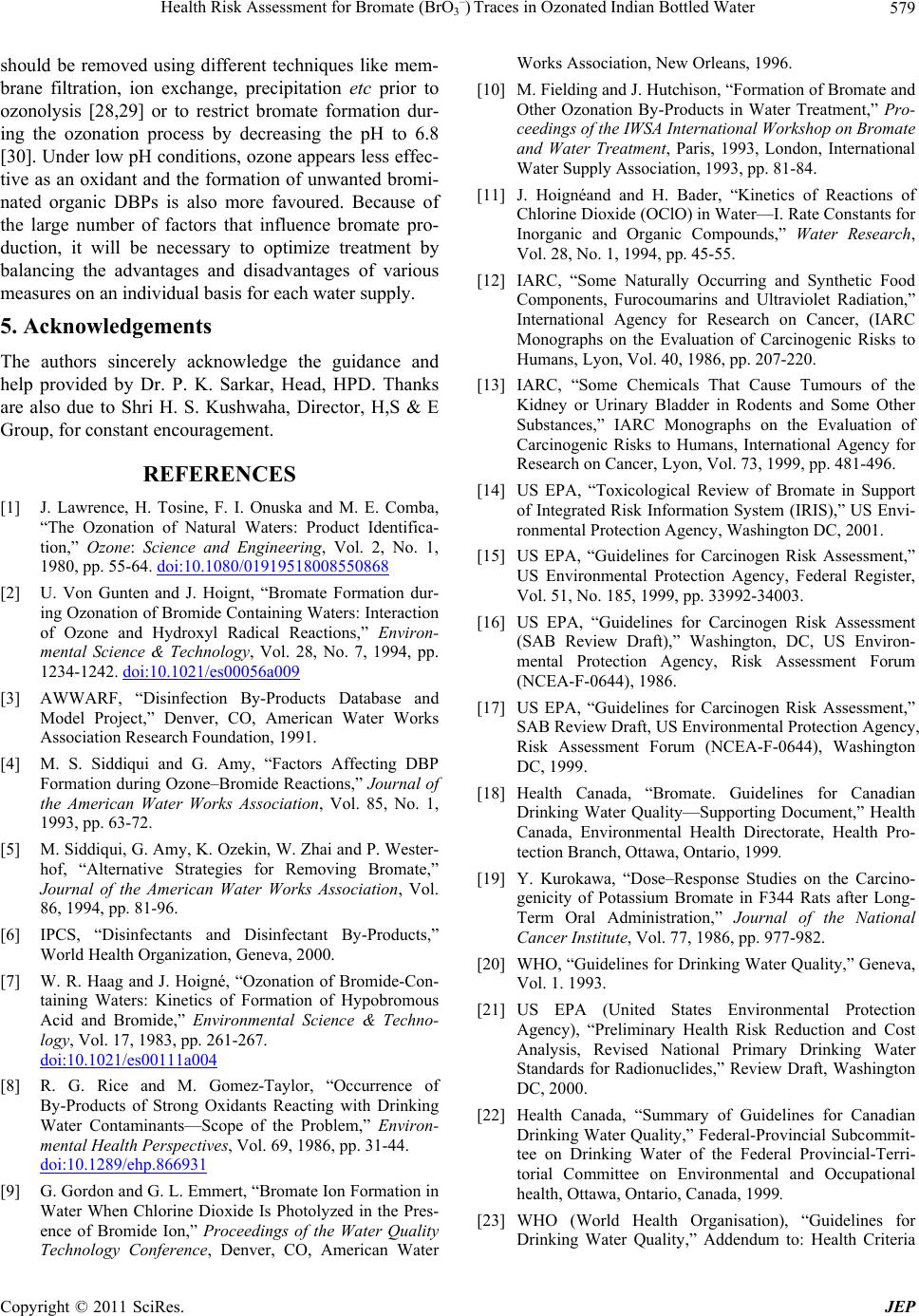
Health Risk Assessment for Bromate (BrO–) Traces in Ozonated Indian Bottled Water579
3
should be removed using different techniques like mem-
brane filtration, ion exchange, precipitation etc prior to
ozonolysis [28,29] or to restrict bromate formation dur-
ing the ozonation process by decreasing the pH to 6.8
[30]. Under low pH conditions, ozone appears less effec-
tive as an oxidant and the formation of unwanted bromi-
nated organic DBPs is also more favoured. Because of
the large number of factors that influence bromate pro-
duction, it will be necessary to optimize treatment by
balancing the advantages and disadvantages of various
measures on an individual basis for each water supply.
5. Acknowledgements
The authors sincerely acknowledge the guidance and
help provided by Dr. P. K. Sarkar, Head, HPD. Thanks
are also due to Shri H. S. Kushwaha, Director, H,S & E
Group, for constant encouragement.
REFERENCES
[1] J. Lawrence, H. Tosine, F. I. Onuska and M. E. Comba,
“The Ozonation of Natural Waters: Product Identifica-
tion,” Ozone: Science and Engineering, Vol. 2, No. 1,
1980, pp. 55-64. doi:10.1080/01919518008550868
[2] U. Von Gunten and J. Hoignt, “Bromate Formation dur-
ing Ozonation of Bromide Containing Waters: Interaction
of Ozone and Hydroxyl Radical Reactions,” Environ-
mental Science & Technology, Vol. 28, No. 7, 1994, pp.
1234-1242. doi:10.1021/es00056a009
[3] AWWARF, “Disinfection By-Products Database and
Model Project,” Denver, CO, American Water Works
Association Research Foundation, 1991.
[4] M. S. Siddiqui and G. Amy, “Factors Affecting DBP
Formation during Ozone–Bromide Reactions,” Journal of
the American Water Works Association, Vol. 85, No. 1,
1993, pp. 63-72.
[5] M. Siddiqui, G. Amy, K. Ozekin, W. Zhai and P. Wester-
hof, “Alternative Strategies for Removing Bromate,”
Journal of the American Water Works Association, Vol.
86, 1994, pp. 81-96.
[6] IPCS, “Disinfectants and Disinfectant By-Products,”
World Health Organization, Geneva, 2000.
[7] W. R. Haag and J. Hoigné, “Ozonation of Bromide-Con-
taining Waters: Kinetics of Formation of Hypobromous
Acid and Bromide,” Environmental Science & Techno-
logy, Vol. 17, 1983, pp. 261-267.
doi:10.1021/es00111a004
[8] R. G. Rice and M. Gomez-Taylor, “Occurrence of
By-Products of Strong Oxidants Reacting with Drinking
Water Contaminants—Scope of the Problem,” Environ-
mental Health Perspectives, Vol. 69, 1986, pp. 31-44.
doi:10.1289/ehp.866931
[9] G. Gordon and G. L. Emmert, “Bromate Ion Formation in
Water When Chlorine Dioxide Is Photolyzed in the Pres-
ence of Bromide Ion,” Proceedings of the Water Quality
Technology Conference, Denver, CO, American Water
Works Association, New Orleans, 1996.
[10] M. Fielding and J. Hutchison, “Formation of Bromate and
Other Ozonation By-Products in Water Treatment,” Pro-
ceedings of the IWSA International Workshop on Bromate
and Water Treatment, Paris, 1993, London, International
Water Supply Association, 1993, pp. 81-84.
[11] J. Hoignéand and H. Bader, “Kinetics of Reactions of
Chlorine Dioxide (OClO) in Water—I. Rate Constants for
Inorganic and Organic Compounds,” Water Research,
Vol. 28, No. 1, 1994, pp. 45-55.
[12] IARC, “Some Naturally Occurring and Synthetic Food
Components, Furocoumarins and Ultraviolet Radiation,”
International Agency for Research on Cancer, (IARC
Monographs on the Evaluation of Carcinogenic Risks to
Humans, Lyon, Vol. 40, 1986, pp. 207-220.
[13] IARC, “Some Chemicals That Cause Tumours of the
Kidney or Urinary Bladder in Rodents and Some Other
Substances,” IARC Monographs on the Evaluation of
Carcinogenic Risks to Humans, International Agency for
Research on Cancer, Lyon, Vol. 73, 1999, pp. 481-496.
[14] US EPA, “Toxicological Review of Bromate in Support
of Integrated Risk Information System (IRIS),” US Envi-
ronmental Protection Agency, Washington DC, 2001.
[15] US EPA, “Guidelines for Carcinogen Risk Assessment,”
US Environmental Protection Agency, Federal Register,
Vol. 51, No. 185, 1999, pp. 33992-34003.
[16] US EPA, “Guidelines for Carcinogen Risk Assessment
(SAB Review Draft),” Washington, DC, US Environ-
mental Protection Agency, Risk Assessment Forum
(NCEA-F-0644), 1986.
[17] US EPA, “Guidelines for Carcinogen Risk Assessment,”
SAB Review Draft, US Environmental Protection Agency,
Risk Assessment Forum (NCEA-F-0644), Washington
DC, 1999.
[18] Health Canada, “Bromate. Guidelines for Canadian
Drinking Water Quality—Supporting Document,” Health
Canada, Environmental Health Directorate, Health Pro-
tection Branch, Ottawa, Ontario, 1999.
[19] Y. Kurokawa, “Dose–Response Studies on the Carcino-
genicity of Potassium Bromate in F344 Rats after Long-
Term Oral Administration,” Journal of the National
Cancer Institute, Vol. 77, 1986, pp. 977-982.
[20] WHO, “Guidelines for Drinking Water Quality,” Geneva,
Vol. 1. 1993.
[21] US EPA (United States Environmental Protection
Agency), “Preliminary Health Risk Reduction and Cost
Analysis, Revised National Primary Drinking Water
Standards for Radionuclides,” Review Draft, Washington
DC, 2000.
[22] Health Canada, “Summary of Guidelines for Canadian
Drinking Water Quality,” Federal-Provincial Subcommit-
tee on Drinking Water of the Federal Provincial-Terri-
torial Committee on Environmental and Occupational
health, Ottawa, Ontario, Canada, 1999.
[23] WHO (World Health Organisation), “Guidelines for
Drinking Water Quality,” Addendum to: Health Criteria
Copyright © 2011 SciRes. JEP